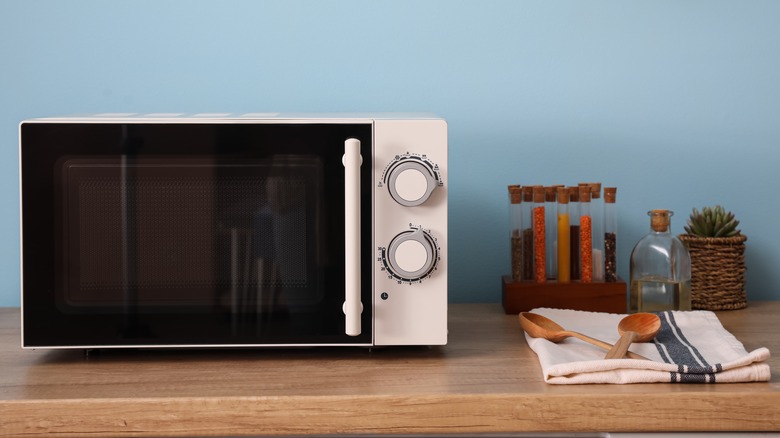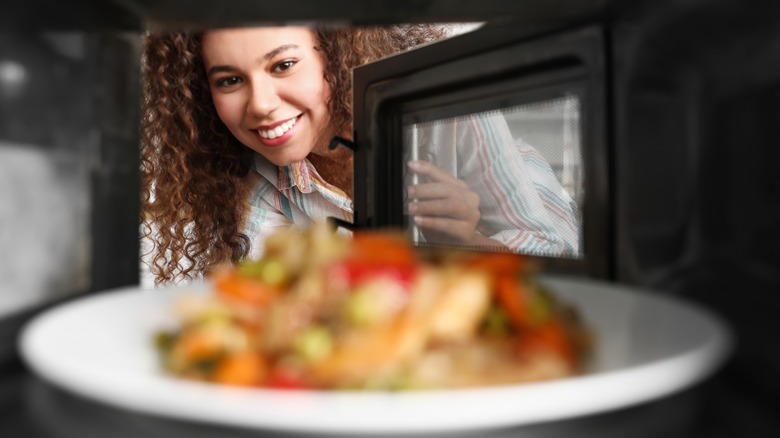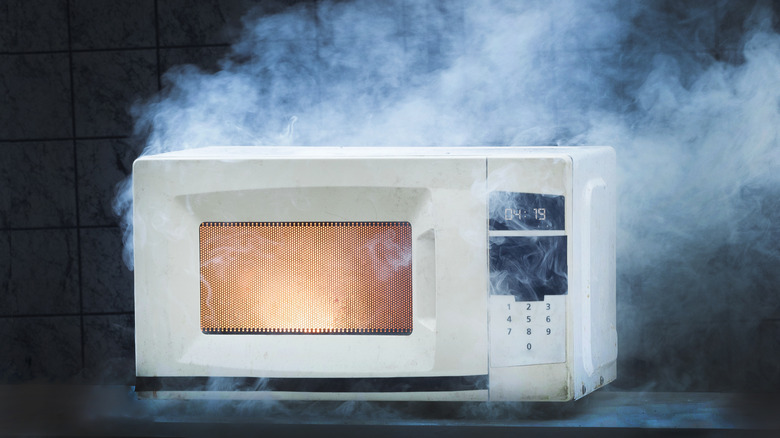The Mesh On Your Microwave Does A Lot More Than You Might Think
Love them or hate them, it's hard to deny the convenience of a microwave. In mere seconds, they can bring leftovers back to life, perfectly melt cheese, or even make an indulgent dessert! But, how safe are microwaves really, and what design features can we rely on to use them without worry?
One important safety feature is the mesh screen that covers the window of a microwave. Most you can buy today come equipped with these screens, which are dotted by pinprick-sized holes that are evenly spaced apart.
The mesh is designed to protect you from the radiation microwaves emit in the process of heating food. While microwaves emit a type of radiation that has much longer wavelengths and are therefore safer than more dangerous radiation-emitting machines like X-rays, you still need to be shielded from unnecessary exposure to radiation, no matter how weak. That's where the mesh on your microwave's window comes in.
The tiny size of the mesh holes is too small for longer waves to exit through, so they keep bouncing back into the appliance rather than exposing you to the energy. The holes also leave you with enough light to see the items heating inside while keeping you safe from radiation as much as possible.
How do microwaves actually heat food?
Microwaves were accidentally invented in 1946 when an engineer, Perry Spencer, was conducting experiments with a magnetron (an electron tube that generates electromagnetic waves). He was surprised by an unexpected side effect: The snack he was testing melted.
This happy accident gave us the modern microwave, which uses a magnetron to harness the power of electromagnetic radiation for heating. Electromagnetic radiation excites and vibrates the molecules inside water, sugar, or fat in your food, heating it from the outside in.
However, microwaves can only travel so far into the item you're heating before losing momentum and weakening. Because of this, the outermost layers of denser foods heat up more thoroughly, allowing the innermost parts to warm up through the conductive transfer of heat.
When you're trying to heat your food all the way through, make sure you don't overdo it because not only will it not taste as you desired but overheating can affect the nutritional value of the dish and could compromise the vitamins and minerals within.
How to make microwave use as safe as possible
Modern microwaves are designed with plenty of safety features; nevertheless, it's important to be aware of proper use and maintenance guidelines and make the most of your microwave. Much of the protective measures in the design are focused on keeping electromagnetic radiation inside the microwave's chamber.
You don't want the energy pulsing out of your appliance, so be sure to replace or repair it if you notice that the door isn't locking closed properly, the protective mesh is peeling off, or if the interlocks are malfunctioning (interlocks are a built-in failsafe that automatically shuts off the microwave's magnetron if the door is opened while heating).
Not everything belongs in the microwave, either. Some plastics are like microwave magnets, and they can melt and mix in with your food. Check out the usage guidelines of your plastic containers, or use ceramics and other microwave-safe kitchenware to heat your food safely.
Microwaving with hard metals — like steel, iron, or copper — is a recipe for disaster, too. These metals reflect the waves of energy, rapidly increasing heat and posing a fire risk. Aluminum foil is also best avoided when microwaving. Technically, it can be used in a microwave, but only if it's kept ultra-flat. If the surface gets crumpled or crinkled, it can cause arcing (sparks that can turn into a fire).



